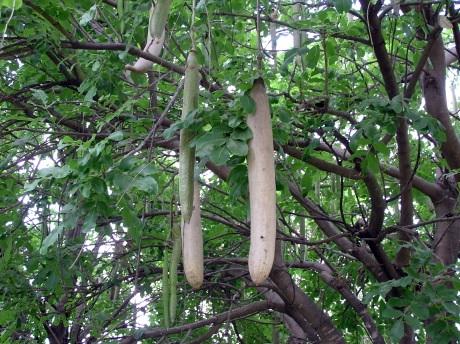The Sausage Tree (scientific name: Kigelia africana) is a fascinating and unique tree species native to tropical Africa, commonly found in countries like Botswana, Namibia, South Africa, and other parts of sub-Saharan Africa.
Key Features and Facts About the Sausagetree:
-
Appearance:
- The Sausage Tree is named after its distinctive, long, sausage-shaped fruit that can grow up to 60 cm in length, resembling large, hanging sausages.
- The tree itself can grow to about 10-20 meters tall, with a broad canopy of large, dark green leaves. Its bark is rough and grayish-brown, providing a textured appearance.
- The tree produces beautiful purple or maroon flowers, which are often large and showy, blooming primarily at night. These flowers are pollinated by bats, which are attracted to their scent.
-
Fruit:
- The most striking feature of the Sausagetree is its fruit, which grows from long stalks and can resemble hanging sausages.
- The fruit is initially green and turns brownish as it ripens. While it’s large and visually impressive, the fruit is not edible in its raw state, as it contains toxic compounds. However, it can be used to make traditional medicines after proper processing.
- The fruit has a strong, unpleasant odor when it ripens, which is why it is often avoided by animals. However, some animals, such as monkeys, may eat the fruit once it has fermented.
-
Habitat:
- The Sausagetree is found in tropical woodlands and savannahs, especially in lowland regions near rivers, streams, or wetlands, where it can access plenty of water. It's native to central and southern Africa and thrives in hot, dry climates with seasonal rainfall.
- The tree can often be found near water sources, where its roots can tap into underground water reserves, especially during dry seasons.
-
Cultural Significance:
- The Sausagetree has cultural importance in many African communities. The bark and fruit are used in traditional medicine for treating various ailments, including malaria, skin infections, and wounds. However, caution must be exercised, as the fruit can be toxic if not prepared correctly.
- In some regions, the tree is also used to make traditional utensils and tools. The tough bark can be woven into ropes and mats, while the wood can be used for carving.
-
Ecological Role:
- The Sausagetree plays an important role in the local ecosystem by providing food for wildlife such as bats, monkeys, and elephants, which may consume the fruits or flowers.
- The tree's large, bat-pollinated flowers provide an important source of nectar for various species, while the fermenting fruit is a food source for different animals in the wild.
-
Conservation:
- The Sausagetree is not considered endangered but may face threats from deforestation and habitat loss due to agricultural expansion and urbanization. However, it is still relatively common in many areas of Africa, especially in protected reserves.
- Conservation efforts in various African countries aim to protect the species, especially in regions where they are threatened by human encroachment.
-
Tourism:
- The Sausagetree can be found in several national parks and nature reserves across southern and central Africa, including famous spots in Botswana, Zimbabwe, and South Africa. The unique look of the tree, especially its hanging sausage-like fruits, makes it a popular subject for photographers and nature lovers.
- Visitors to areas like Chobe National Park in Botswana or Kruger National Park in South Africa may have the chance to see these fascinating trees as part of their safari experience.
Conclusion:
The Sausagetree is a unique and visually striking species with both ecological and cultural significance in Africa. While its hanging sausage-like fruit is one of its most distinguishing features, the tree also plays a vital role in supporting local wildlife and is deeply intertwined with African traditions.





